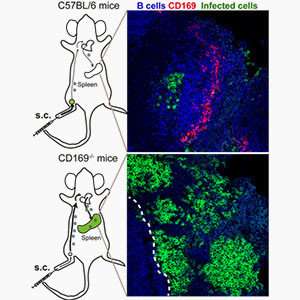Innovative way to block HIV runs into a roadblock

Taking aim at a promising molecular target can combat the spread of retroviruses that can cause blood cancer and AIDS—but at the risk of leaving the host vulnerable to infections by other viral pathogens, a new Yale study has shown.
HIV and mouse retroviruses both hijack immune cells called macrophages to spread from body fluids into lymphatic tissues. The Yale team led by Pradeep Uchil and Walther Mothes found that blocking a lectin CD169 on the surface of these macrophages can reduce retrovirus infection in a mouse model. However, doing so left the mice vulnerable to other pathogenic retroviruses that cause blood cancer, the researchers found.
"Retroviruses evolved over a million years to co-opt this system, but blocking this mechanism really hampers the immune response against pathogenic viruses," Mothes said.
In 2015, Mothes and Yale colleagues discovered the role CD169 played in retrovirus spread and hypothesized that blocking it would play a role in reducing infection of retroviruses that cause leukemia and AIDS. Researchers should be cautious in pursuing this target given the new findings, the authors said.
The research was published Dec. 27 in the journal Cell Host & Microbe.

















